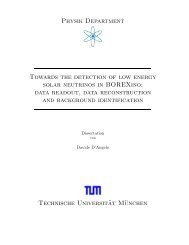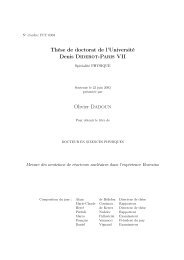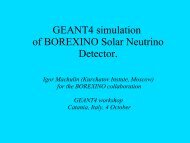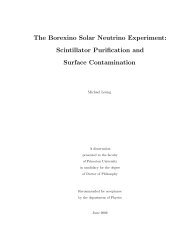Development of a Liquid Scintillator and of Data ... - Borexino - Infn
Development of a Liquid Scintillator and of Data ... - Borexino - Infn
Development of a Liquid Scintillator and of Data ... - Borexino - Infn
You also want an ePaper? Increase the reach of your titles
YUMPU automatically turns print PDFs into web optimized ePapers that Google loves.
4. If the photon reaches a surface:<br />
4.2 The Tracking <strong>of</strong> the Scintillation Photons<br />
- Inner Vessel Radius, 425 cm (only for water buffer): Reflection? Refraction? Calculate<br />
new direction (Ù Ù ), index <strong>of</strong> refraction in the new medium, <strong>and</strong> continue<br />
with 2.<br />
- Radius <strong>of</strong> PMTs with cones, 635 cm: Cone aperture hit? Is it reflected by the cone?<br />
If it is accepted, proceed to the PMT. Is it reflected on the surface? If not, go to 5,<br />
otherwise continue with 2.<br />
- Radius <strong>of</strong> PMTs without cones, 655 cm: PMT hit? If yes, is it reflected? If not,<br />
goto 5, otherwise calculate reflection angle <strong>and</strong> continue with 2.<br />
- Stainless Steel Sphere, 685 cm: absorption or reflection on stainless steel?<br />
5. PMT hit: the photon is converted into a photoelectron according to the photocathode<br />
efficiency. Calculate the time jitter <strong>and</strong> the pulse height signal. If the pulse height is<br />
above the threshold, store the time <strong>of</strong> the signal.<br />
When the grid for the reconstruction is computed, the program loops over a spatial grid, where<br />
a fixed number <strong>of</strong> photons starts from each grid point. In the end, only the time <strong>of</strong> the first<br />
photoelectron <strong>of</strong> each PMT is stored for each grid point. This simulation has to be done with<br />
a very high statistics, in order to get the earliest possible arrival time <strong>of</strong> a photon at each PMT<br />
Ø min Ü Ý Þ .<br />
The probability density function for a single photoelectron Ø is derived from a Monte Carlo<br />
simulation, where a number <strong>of</strong> photons starts from the center <strong>of</strong> the detector (so that the distance<br />
to all PMTs is the same) <strong>and</strong> is stored in a separate file. This probability density function<br />
reflects the decay time <strong>of</strong> the primary scintillation light emission, additional delays introduced<br />
through absorption <strong>and</strong> reemission, scattering, reflection, etc. <strong>of</strong> the photon on its way to the<br />
PMT, <strong>and</strong> the time jitter <strong>of</strong> the PMT. In principle, this distribution also depends on the distance<br />
between the primary emission point <strong>and</strong> each individual PMT, but in the first order it is the<br />
same for all positions inside the scintillator. Fig. 4.7 shows the averaged probability density<br />
function for the CTF for two different positions, in the center <strong>and</strong> in a distance <strong>of</strong> 94 cm from<br />
the center (corrected for the time <strong>of</strong> flight to the PMTs). There are notable differences only<br />
for late arrival times, which do not provide good information for the position reconstruction,<br />
anyway.<br />
53








